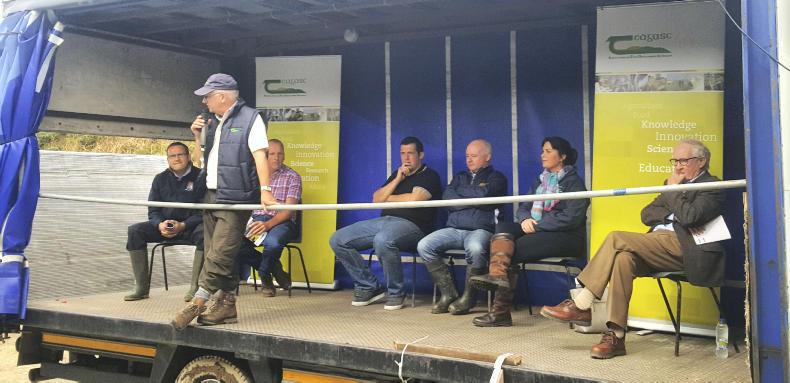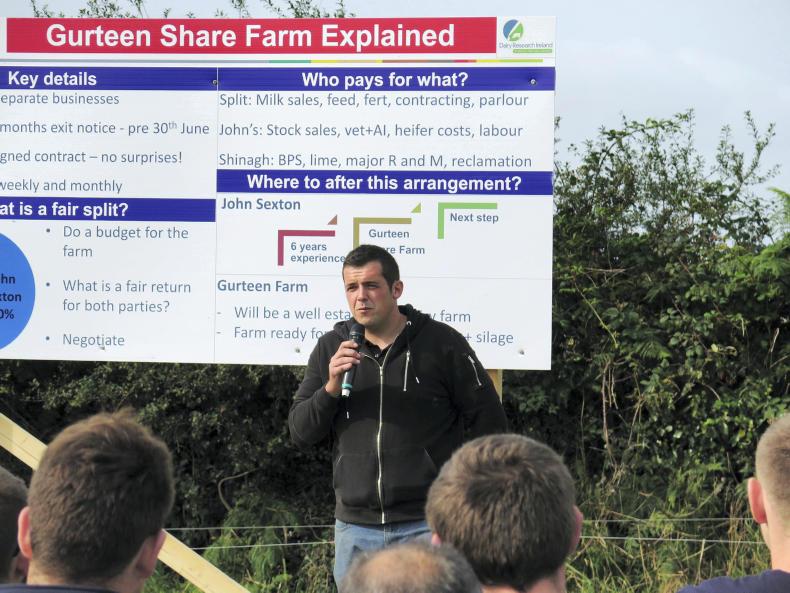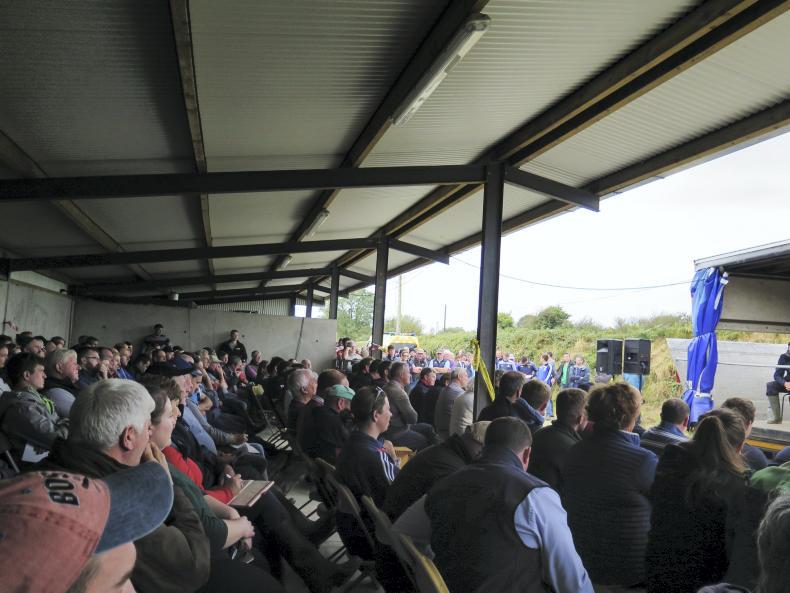Last week, we examined the share-milking farm in Bandon being operated by John Sexton and Shinagh Estates.
At 93 cows, the margins for John were extremely tight in 2016.
Profitability
Profitability will be much improved this year with higher animal performance and a better milk price. But what can be done to make share-milking more resilient in times of low milk price? Is it just down to herd size, or can other things be done?
Last year
Last year, John made €37,154 from share-milking and out of this he had to pay for his own living expenses, repay debt on the herd purchase, pay for the rearing of his heifers and pay for the costs of replacements for 2017.
So things were extremely tight and John’s side of the business operated at a cash loss for 2016, despite John being on a 60:40 share-milking agreement in favour of John.
On a per-cow basis, the €37,154 works out at about €408/cow for John.
If John was milking 150 cows, and if the cost and output per cow was to remain unchanged, then his net profit would have been €61,164, from which he would deduct living expenses, debt repayments, etc.
Is it too simplistic to say that the cost structure would be the same?
When it comes to increasing cow numbers, the big variable is labour. At what point does John need extra labour? At the moment, with 93 cows, he manages on his own with relief milkers to cover days off and holidays.

All machinery work is contracted out, and his replacement heifers are reared on the home farm in Donoughmore with help from his father.
The layout and the facilities on the share-milking farm at Gurteen are excellent, which helps to reduce the workload.
For someone with John’s experience and ability, managing 150 cows without hiring a second full-time labour unit should be very doable, without affecting his work/life balance or adversely affecting herd performance. Of course, the proviso being that farmyard facilities would be scaled up accordingly.
Having more cows makes the pot of money from which John has to service his commitments greater and gives him scope to make more money in the good milk price year. Milk price volatility is here to stay and in low milk price years the cash surplus is often small or non-existent. So it is even more important to make a substantial cash surplus in the good years.
While this could be said of any farm, it is even more critical for young and ambitious farmers like John. They need a high return on their capital and they need to generate enough free cash to springboard them into their next farm. So return on capital is important but so too is the amount of money being generated.
But on the flip side, getting a larger herd in your first year could be beyond the capacity of many share-milkers. While John was able to afford to buy 100 cows, buying 150 or 160 might have been beyond what he was willing to finance. This is where lower order share-milking might come in, whereby the share-milker/farm manager owns a lower proportion of the herd, and takes a smaller cut of the costs and milk cheque but will be on a salary for managing the farm.
Most share-milking agreements in New Zealand are for three-year periods, with some of them rolling over for another three years. John’s agreement is for seven years, but there is a clause in the agreement that John can leave after three years with a minimum notice period of six months and before 30 June, so as to give Shinagh Estates sufficient time to recruit a new share-milker.
John hopes to move on to a larger farm after three years, if a suitable opportunity arises. He says he would like to be in a position to own over 200 cows at that stage, either in another share-milking farm, on his own leased farm, or in a partnership with another farmer where he manages the farm and owns a share of the herd.
Employed farm manager vs share milker?
Since the open day, a number of farmers have been wondering if John would be better off being an employed farm manager rather than being a self-employed share-milker.
For someone with John’s energy, enthusiasm and skill set, he could demand a good salary and a choice of employment.
In terms of hard cash, there’s no doubt that if John was on a salary last year, he would probably have had more time off over the year and would have more free cash.
But that’s not the full picture.
By taking on the share-milking job he has learned new skills and got experience that he might not get as an employee.
Skills such as financial budgeting, managing through tight times, project management, dealing and negotiating with business partners and banks, buying stock, etc.
By buying the cows he is also growing his net worth. While only interest was paid on the stock loan in 2016, the heifer calves born are all assets that increase in value and can be sold at any time. These are now in-calf heifers and a new batch of heifer calves were born this year. He is now paying down debt so his equity in the herd is increasing too.

There is also the non-tangible advantages such as the satisfaction of working with his own cows and being his own boss. Yes, if he was an employee he could use free cash to buy calves and rear them up and many employees do this to grow their savings.
Leasing v share-milking
Other farmers were wondering if leasing a farm was a better option for a young person. Some felt that having to share the costs and milk cheque was too much to give away and that if John was to lease a similar-sized farm he would have more out of it.
But if John was to lease the Gurteen farm off Shinagh, he would have had to invest in capital infrastructure himself – roadways, water, cubicles, milking parlour and calf shed and then go out and buy cows. There’s no way he would have been able to finance all of this and have the same number of cows.
Yes, he could find an existing dairy farm to lease and while he would probably pay more in lease costs, he would not have to invest as much as if on a greenfield site. However, more often than not some capital investment is needed on a leased farm, whether on upgrading the parlour, housing, roadways or water system. On some farms, the cost of capital expenditure will be shared between the person leasing the farm and the farm owner. But on other farms a return on investment is given to the farm owner for capital employed. Effectively, the person taking on the lease is paying for the capital invested on the farm in one way or another.
This is why share-milking is a much more attractive prospect for a young person as all the money they spend on the farm is either on a hoof or on wheels and can be walked or rolled off the farm at the end of the term.
Share-milking is not for everyone. Both parties need to be good businesspeople.
They also need to be good with people and have an ability to see things from another person’s perspective.
There must be trust and integrity for the agreement to work. For the young person, it’s an excellent way to grow their wealth but excellent farm performance and a minimum number of cows is required to generate sufficient profits for future growth.
What the minimum number of cows is will depend on the situation, but 100 cows in the best farming region in the country is probably not enough.
Could fizzy milk be sitting on shop shelves?
Fonterra confirms bid for Australia’s largest dairy processor Murray Goulburn






 This is a subscriber-only article
This is a subscriber-only article










SHARING OPTIONS: